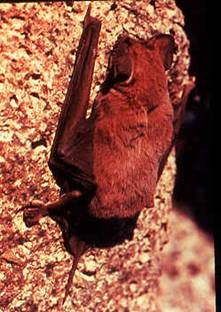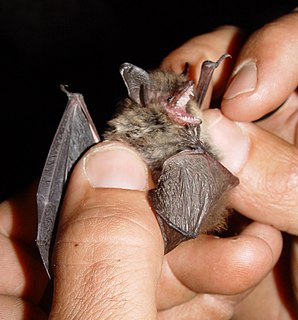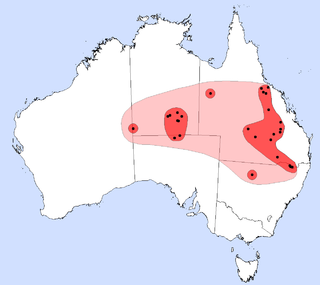
The Molossidae, or free-tailed bats, are a family of bats within the order Chiroptera. The Molossidae is the fourth-largest family of bats, containing about 110 species as of 2012. They are generally quite robust, and consist of many strong-flying forms with relatively long and narrow wings with wrinkled lips shared through their genus. Their strong flying forms allows them to fly 60 miles per hour using tail winds and at altitudes over 10,000 feet. This makes them unique among bats, as they are the only bat family that withstands the elevation. They are widespread, being found on every continent except Antarctica. They are typically found in caves, abandoned mines, or tunnels.

Mormopterus is a genus of molossid microchiropterans, small flying mammals referred to as free-tailed bats. The genus has been the subject of several revisions, and the diversity of taxa centred on Australia were separated to a new genus Ozimops, and two monotypic genera, Setirostris and Micronomus. The species of Mormopterus, in this stricter sense, are only found in areas outside of Australia and West Papua.

The mouse-eared bats are a diverse and widespread genus (Myotis) of bats within the family Vespertilionidae.

Micronomus norfolkensis is a species of molossid bat, a family of flying mammals. The bat is endemic to Australia, where it occurs from southeastern Queensland to eastern New South Wales. They are the sole species of genus Micronomus and referred to by variations on east-coast free-tailed bat.

Beccari's free-tailed bat is a species of bat in the free-tailed bat family Molossidae found to Indonesia and Papua New Guinea. This bat can be found in several habitat types, including savanna, tropical moist forest, and fragmented and urban habitat. It roosts in trees, caves, and buildings in small colonies. This is a common species which is not considered to be threatened. The names Beccari's free-tailed bat or Beccari's mastiff bat once applied to populations in Australia.

Ozimops planiceps is a small bat in the family Molossidae, native to Australia and Indonesia.

Peters's wrinkle-lipped bat(Mormopterus jugularis), also called Peters's goblin bat, is a species of bat in the family Molossidae, the free-tailed bats. It is endemic to Madagascar, where it is widespread and in some areas abundant. It commonly roosts in human-made structures, sometimes in colonies with other free-tailed bat species. It forages in the open, often in agricultural areas. The bat is sexually dimorphic, with males larger than females.

The western or inland broad-nosed bat is a species of vespertilionid bats. They are endemic to Australia and widespread throughout the inland, especially in arid and semi-arid regions. This insectivorous microbat, measuring 12 cm in length, roosts in tree hollows during the day and forages over woodland and water at night.
Myotinae is a subfamily of vesper bats. Submyotodon is the second extant genus included in the subfamily Myotinae. Before the description of Submyotodon and analysis of its phylogenetics, the only member of Myotinae was the genus Myotis.

Setirostris eleryi is a species of small insectivorous bat found in inland eastern Australia. It is the sole species of the molossid genus Setirostris, a name that refers to the coarse bristles on their faces. Earlier common names have referred to this unique feature, and the 'free-tail' that is a common feature of its microchiropteran family, the Molossidae; no single common name emerged during the taxonomic revisions that identified what was referred to as the bristle-faced freetail.
Ozimops loriae is a species of bat found in Australia and Papua New Guinea.
Ozimops ridei is a species of molossid bat found in eastern Australia.
Ozimops petersi, the inland free-tailed bat is a species of bat found in Australia.
Ozimops kitcheneri, the south-western free-tailed bat, is a species of molossid bat found in Southwest Australia. A small flying mammal, it forages in forests and woodlands for insects.
Darrell John Kitchener is a biologist who has been active in mammalian research in Western Australia and Indonesia. He is the author of over one hundred papers, published while employed as the senior research biologist at the Western Australian Museum, and described many new species of mammals during his 28 years in that position. Kitchener was born on 9 June 1943 in Victoria, Australia. He obtained degrees in botany and zoological sciences at the University of Tasmania and completed his Ph.D. at the University of Western Australia. His works include contributions to the Australian Museum's Complete book of Australian mammals.
Ozimops lumsdenae is a species of molossid bat found in Australia, the largest of the genus Ozimops.
Ozimops cobourgianus is a species of molossid bat, insectivorous flying mammals known as freetail bats, which are found in north and west coastal regions of Australia. First described in 1959, the group were later recognised as species Mormopterus cobourgianus and soon placed with a new genus. They are associated with mangrove habitat and roost in the hollows of those trees, and known to seek food there and in eucalypt or melaleuca woodland or other coastal habitat. A smaller bat of genus Ozimops, O. cobourgianus are around fifty millimetres long and weigh six to ten grams. Little is known of their habits.
Ozimops halli, also referred to as the Cape York free-tailed bat, is a species of molossid bat found at the Cape York Peninsula in Australia.







